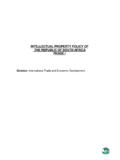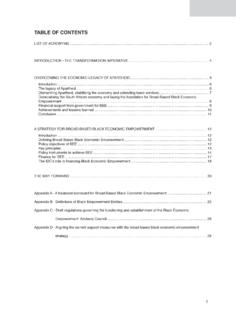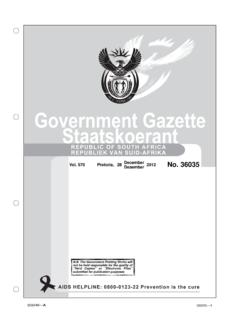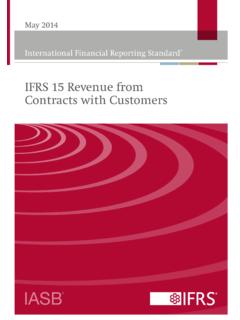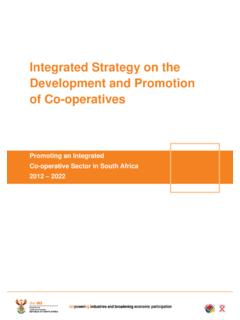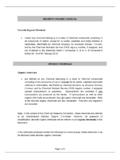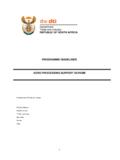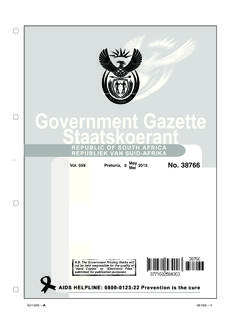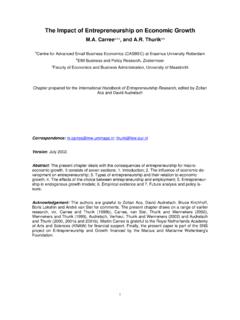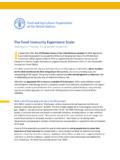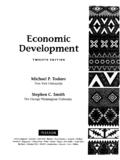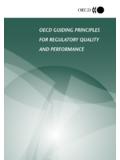Transcription of BACKGROUND TO, INTENTION & APPLICATION …
1 Introduction This guide has been developed as an interpretation aide for individuals and entities seeking to gain further clarity and understanding of the Codes of Good Practice ( the Codes ). This guide should not be viewed as a replacement for the content of the Codes, but rather, should be read in conjunction with each Statement, as a means of further clarification. The Purpose of the Codes of Good Practice Before the release of the Strategy on Broad-Based BEE1, there was no framework in existence for the measurement of broad-based BEE. The Strategy provided the outline of a broad-based scorecard, together with weightings, but did not contain detail on measurement principles and the APPLICATION of the scorecard. By the beginning of 2004 when the BEE Act was promulgated, numerous sectors of the economy had drafted industry charters on BEE and transformation. Whilst some contained scorecards loosely based on the broad-based scorecard contained in the Strategy, others were merely written undertakings of commitment to transformation.
2 In addition, several of these charters were drafted prior to the release of the Strategy and stakeholders therefore had little point of reference in terms of broad-based elements and weightings. Furthermore, it became evident that other pertinent issues surrounding the measurement of BEE needed to be addressed to further accelerate the transformation process. 1 South Africa s economic Transformation: A Strategy for Broad-Based Black economic Empowerment 1 BACKGROUND TO, INTENTION & APPLICATION OF THE CODES OF GOOD 3/15/2007 7:16 PM Page 1 Summary of Obstacles, Implications, Solutions presented by the Codes and Relevant Statements: Historical BEE Implementation Obstacles Implications Solution presented by the Codes of Good P Practice Applicable COGP Statements Lack of uniform framework for the recognition and measurement of BEE Created confusion as the same BEE initiatives or transactions may have received different BEE recognition by different organs of state, business entities and verification agencies Standardisation of BEE recognition and measurement principles to provide clarity Primary: Statement 000 Secondary.
3 Codes of Good Practice in general Extensive delays in BEE implementation due to differences in interpretation Sectors were often locked in contentious debates around certain aspects of BEE, thereby delaying the implementation of broad-based BEE initiatives Standardisation of BEE recognition and measurement principles to provide clarity Primary: Statement 000 Secondary: Codes of Good Practice in general Disparity in definitions and targets in charters and other BEE requirements Different charters introduced definitions, targets and processes which may have diluted or negated the impact of the Strategy and circumvented the principles of the BEE Act Specification of the requirements for the development and recognition of industry charters (reducing disparity in principles and definitions as a result of industry charters) Primary: Statement 000 Secondary: Codes of Good Practice in general Status of transformation charters was unclear Confusion and delays in BEE implementation resulted since companies were uncertain as to the status and APPLICATION of charters Specification of the requirements for the development and recognition of industry charters Primary: Statement 003 Lack of underlying economic substance to many BEE transactions Many BEE transactions boasted high percentage levels of legal black ownership, but often the actual economic benefits accruing to black shareholders proved to be significantly lower Provision of a balanced ownership scorecard which measures voting rights and net economic interest in the hands of black people Primary.
4 Statement 100 Fronting due to lack of implementation guidelines Lack of understanding of BEE and its elements often resulted in fronting and meant that fronting was more difficult to detect Provision of definitions, principles and processes to implement proper BBBEE initiatives Primary: Statement 100 Secondary: The Codes of Good Practice in General Very little transformation within management levels Despite various attempts at transformation within entities there is still a lack of sufficient representation of black people within management levels. The codes encourage focus to be given for black representation at junior, middle, senior and top management levels within organisations. Primary: Statement 200 & 300 Uncertainty as to what type of skills development initiatives could be counted towards skills development spend Skills spend may not necessarily have been aligned to a particular learning outcome Alignment of skills development spend on black employees to the learning programme matrix as issued under the Skills Development Act to ensure clear and quantifiable outcomes Primary: Statement 400 Narrow-based recognition tended to benefit a limited number of black people with access to capital Only a limited number of black people have tended to benefit from black economic empowerment to date The Codes promote broad-based BEE which by encouraging that procurement opportunities be made available to B-BBEE compliant suppliers, Black owned and black women owned entities, small and micro enterprises Primary: Statement 500 3/15/2007 7.
5 16 PM Page 2 Historical BEE Implementation Obstacles Implications Solution presented by the Codes of Good Practice Applicable COGP Statements Lack of awareness of enterprise development in and of itself, as well as a lack of awareness of what constitutes enterprise development Unlike corporate social investment, enterprise development is a fairly new concept and fairly specific to broad-based BEE. For this reason, the lack of documentation with examples of what constitutes enterprise development has made enterprise development one of the least implemented elements on the scorecard. Code 600 outlines the principle of enterprise development, as well as supplying numerous examples of what kinds of initiatives constitute enterprise development Primary: Statement 600 Corporate social investment initiatives were not necessarily linked to the objective of brining their beneficiaries into the mainstream economy The black majority remain largely outside of the mainstream economy Code 700, whilst acknowledging that certain social objectives may not necessarily facilitate access to the mainstream economy, nevertheless encourages the implementation of initiatives which are socio- economic in nature and which are linked to the concept of assisting black people to be better equipped to access the mainstream economy Primary.
6 Statement 700 BEE was seen as an obstacle to small business development due to an increase in the regulatory burden Small businesses tended to ignore BEE or resort to fronting techniques to maintain clients for business purposes. Exemption of all entities with an annual turnover of less than R 5 million. The inclusion of comprehensive statements for the measurement of broad-based BEE amongst Qualifying Small Enterprises (QSE s), based on a flexible approach where QSE s are only measured against 4 of the 7 elements of their choice. QSEs are those entities with a turnover level of between R5million and R35million per annum. Primary: Code series 800 3/15/2007 7:17 PM Page 3 History & Legal Framework When the shortcomings of narrow-based black economic empowerment2 ( BEE ) became apparent towards the end of the nineteen nineties, a need emerged for a more inclusive approach to empowerment which would begin to narrow the divide between the first and second economies by putting mechanisms in place to accelerate the entry of black people into the first economy.
7 This approach became known as broad-based black economic empowerment ( B-BBEE ). Subsequently, a document titled A Strategy for Broad-Based Black economic Empowerment was released in 2003. This document not only defined broad-based BEE and the transformation imperative, but outlined the first broad-based scorecard comprising the seven elements of broad-based BEE. The seven elements and their respective weightings out of 100 are depicted below, as per the Generic Scorecard contained in the Codes: ELEMENT POINTS Ownership 20 Management Control 10 Employment Equity 15 Skills Development 15 Preferential Procurement 20 Enterprise Development 15 Socio- economic Development 5 TOTAL 100 POINTS The Strategy was followed by the Broad-Based BEE Act No. 53 of 2003 Broad-Based BEE Act No.
8 53 of 2003 ( BEE Act ), which was promulgated in January of 2004. In section 10, the Act outlines government s leverages for the implementation of broad-based BEE, meaning that organs of state and public entities must take an entity s BEE status into account when: x determining qualification criteria for the granting of licences and concessions x developing and implementing a preferential procurement policy x determining qualification criteria for the sale of state-owned enterprises x developing criteria for entering into partnerships with the private sector 2 Black economic empowerment by means of the elements of ownership and management exclusively 3/15/2007 7:18 PM Page 4 The BEE Act (abbreviated in the Codes and defined as the Act ) is an enabling legislative framework which allows for the development of the CoCodes of Good Practice.
9 The Codes provide a standard framework for the measurement of broad-based BEE across all sectors of the economy. This means that no industry will be disadvantaged over another when presenting their BEE credentials. Statement 003, which provides guidelines for the alignment of transformation charters to be gazetted as Codes of Good Practice, will ensure that even when different gazetted charters are applied to different entities presenting their BEE credentials, neither of the entities will be unfairly disadvantaged over the other because of the APPLICATION of a more stringent industry charter. The INTENTION of the Codes of Good Practice is therefore to level the playing field for all entities operating within the South African economy by providing clear and comprehensive criteria for the measurement of broad-based BEE. 3/15/2007 7:18 PM Page 5 The table below, reproduced from Statement 000, provides a detailed guide to the organisation and content of the Codes: Further statements not presently included in the Codes, may be issued from time to time.
10 In such cases, these statements will be included under the relevant Code series. CODE STATEMENT Statement 000 The General Principles and the Generic Scorecard Statement 001 The Qualifying Small Enterprise (QSE) Scorecard and Exempted Small & Micro Enterprises Statement 003 Guidelines for the Development and Gazetting of Transformation Charters and Sector Codes Code 000 Framework for the Measurement of B-BBEE (Carries general principles and Generic Scorecard) Statement 004 Recognition for the sale of assets Statement 100: The General Principles for Measuring Ownership Statement 102: The Recognition of Qualifying Ownership Transactions Code 100 Measurement of the Ownership Element of B-BBEE (Measures the effective ownership of enterprises by black people) Statement 103: The Recognition of Equity Equivalents for Multinationals Code 200 Measurement of the Management Control Element of B-BBEE (Measures effective control of enterprise by black people) Statement 200.
